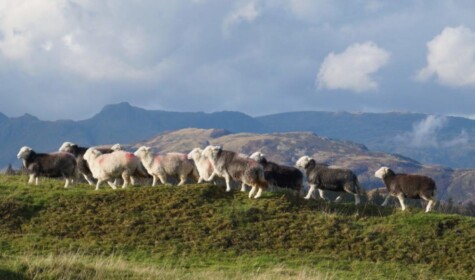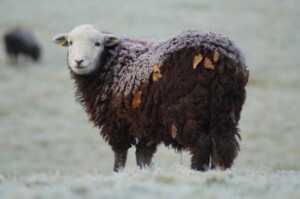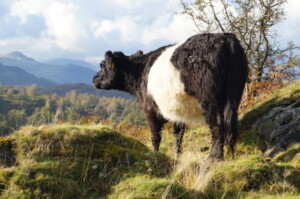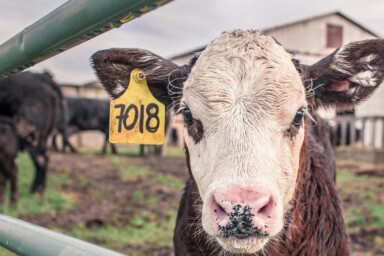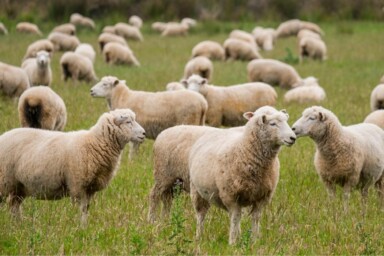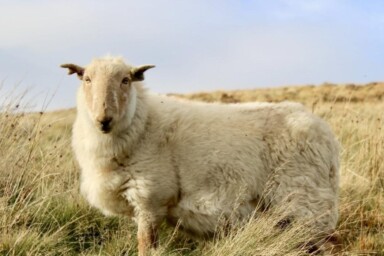Tasting the meat from my first batch of Gloucester Old Spot pigs was a revelation. What I found out was that the taste is more intense, the texture firmer and the colour far richer than intensively produced pork reared for the supermarkets – it really was profoundly different. Pork from heritage breed pigs needs just two simple ingredients: time and nature. The reward is exceptionally tasty meat and the fat makes incredible crackling!
But this profound difference is no surprise when you compare the way in which my heritage pigs were reared to intensively farmed pigs. Philip Lymbery, chief executive of Compassion in World Farming (CIWF) reports as much as 90% of pork sold in the UK is intensively farmed. Piglets are born to sows in farrowing crates, which are so small the sows can’t even turn around. The piglet’s teeth are painfully clipped, their tails docked and they are weaned at three weeks old. The growing pigs live on hard slatted floors, so their waste can conveniently be washed away. Hormones are often given to pigs to grow quickly (though this is not the case in the UK and Europe as growth hormones were banned in 2006) and routine antibiotics are used to reduce the spread of disease in tightly packed conditions – how can anyone think this is acceptable? Will this produce food that is good to consume and nutritionally rich?
Heritage breeds were sidelined
My generation has seen the devastating impact of the rise in supermarkets which have put pressure on farmers to farm more intensively, to produce more food quickly and cheaply, but this meat is produced at the expense of animal welfare, the environment and taste. Our heritage breeds were sidelined when intensive farming came in. Breeds like Tamworths, Middle Whites, Saddlebacks, Gloucester Old Spots, Dexters, Belted Galloways, Longhorns and Herdwicks couldn’t make the correct weight and confirmation in the required timescales for the supermarkets, and the cuts of meat didn’t fit the packaging. Supermarkets pay farmers based on carcase classification grids which relate to the confirmation of the animal (well developed muscles around the shoulders, back and buttocks) and fat cover (a grade of ‘1’ being too lean to ‘5’ being too fat).
Middle White Pigs, also known as ‘The London Porker’ in the 1950’s because of high demand from London restaurants, were extremely popular because of the quality of the well-marbled meat which chefs considered had a remarkable flavour (widely recognised as the result of higher intermuscular fat levels). However, the supermarket demand for lean pigs for pork and bacon production led to a decline in the Middle White Breed and it became endangered.
What makes heritage breeds special?
I love talking about the different characteristics of our heritage breeds and why they thrive in each of their different natural environments; they are produced slowly and naturally, and that’s of the utmost importance.
A fine example are Belted Galloways. These black cattle with a distinctive white belt, called ‘Belties’ for short, hail from beautiful South West Scotland. They are perfectly suited to the harsh upland climate of the Galloway hills, where they turn a variety of rough hill pasture and herbs into the finest quality beef. They are a hardy breed with a double layer of hair: a long coarse outer layer that provides unbeatable protection from rain and wind, and underneath this, a thick soft insulating layer of hair doesn’t get wet, which is good for energy efficiency. Their double coat of hair means they don’t need the backfat most other breeds require. Their meat is therefore leaner than many native breeds, but equally succulent. ‘Belties’ are small and sturdy and have remarkable foraging abilities, negotiating even the most inaccessible areas to find food. They graze differently to sheep and therefore are superb for managing certain habitats with sensitive plant species – they are important in conservation and improving biodiversity. For instance Belted Galloways have been used to manage areas of fells that has been smothered by bracken. They help break up the thick leaf litter, trample the bracken and allow other plants to re-establish, maintaining a diverse habitat that supports a wide range of important wildlife species.
Another excellent example is Dexter beef which has outstanding quality and flavour, with good marbling. The smallest British cattle breed, in fact about half the size of modern commercial cattle, Dexter beef is now popular with informed consumers and chefs because of the excellent eating quality of small, trim cuts and joints. (The breed is not however popular with supermarkets – when I worked as procurement manager for a co-operative of organic farmers selling livestock to supermarket processors, I was given a dressing down for sending some Dexter Cattle into the supermarket abattoir and told not to send them again as they were too small!) Dexter beef can mature relatively quickly on a natural diet of grass alone, without supplementary feeding. Their small stature and hardy nature means they are well suited to grazing Fells and Upland pastures, Dexter’s being a good choice for conservation grazing. The Dexter breed has Irish roots, originating in Tipperary in 1750, when a Mr Dexter developed the breed by selecting the best of the hardy mountain cattle of the area descended from the ancient black cattle of the early Celts.
I started the Real Food Hub because I wanted to provide an alternative to intensively produced meat, and I wanted to make it more convenient to buy directly from farms rearing heritage breed beef, lamb and pork for three key reasons:
- animals live and thrive in their natural environment;
- they play an important role in preserving the biodiversity of our natural habitats;
- the meat is healthy to eat, produced without antibiotics and concentrates and grass-fed. It contains nutrients that help protect against many modern diet-related illnesses.
Real Food Hub producers rear small groups of animals on a small-scale, the way they were produced before intensive systems were widespread.
Small abattoirs are disappearing at a shocking rate, in part because of the centralisation of larger abattoirs, driven by the supermarket system and increased regulation. At Real Food Hub, all our small-scale farmers take their animals to a small local abattoir about 10 – 15 miles away, and I know how much better smaller abattoirs are for keeping animals less stressed. The particularity of breed is important and smaller abattoirs can preserve this, returning meat to producers rather than anonymising it. If an animal is destined for our dinner plate, I want it to have the best life and the most humane end. Top chefs and butchers would also tell us that less stress for the animal means better tasting meat. I would not want my animals to end their lives in a huge factory operation.
We have a new ‘Shop by Breed’ feature which encourages customers to engage more with specific breeds in diverse animals. We also include special types of meat such as Salt Marsh Lamb and Rose Veal. We have developed this to try and raise the profile of these breeds and types of meat so that more customers buy them and ensure their survival.
Whilst it’s true that the biggest difference in colour, taste and texture will be found between all heritage breeds versus modern breeds, there are also differences within the heritage breeds.
The price grading systems for supermarket meat have resulted in one ‘modern pig’ from a handful of corporations owning the genetics for highly specialised animals to produce the maximum amount of lean meat in the least amount of time; for UK pork production this means factory farming where the main goal is profit not animal welfare.
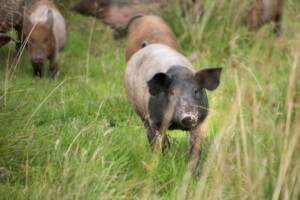
It’s a good deal!
With the rise of supermarkets, the proportion of our income we are prepared to spend on food has reduced dramatically. But buying heritage breed meat does not have to break the bank. Many of our customers buy meat boxes, where farmers are utilising the whole carcase. Meat boxes can actually work out to be a really economical way to shop; customers can fill their freezer and stock up.
At Real Food Hub, we tell the story of each farmer just as you would find at a farmers market.
www.realfoodhub.co.uk/category/heritage-breed-meat
Photographs: Jon Watson, Yew Tree Farm, Cumbria and Sarah Jane at Porcus, Yorkshire.
